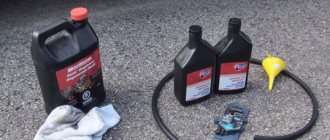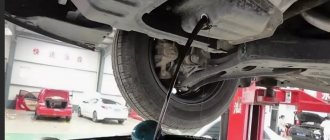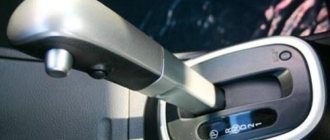The automatic transmission on the Hyundai Solaris is a “classic” hydromechanical automatic transmission. Such boxes are considered quite durable and reliable, subject to proper and regular maintenance. At the same time, Hyundai officially indicates in the manual that an oil change in the Solaris automatic transmission is not required and the fluid is designed for the entire service life of the unit.
However, in practice:
- transmission oil becomes actively contaminated;
- additives in oil stop working after 3 years or after 50-60 thousand kilometers.
- under certain conditions, an oil change may be necessary and intervals may need to be reduced;
For this reason, experienced specialists recommend changing the Solaris automatic transmission oil regularly. It is also important to choose the right lubricant and avoid mistakes when replacing. Read more in our article.
Step-by-step replacement instructions
Let's consider several replacement options in 4AT and 6 AT boxes, as well as at the end of the article there is a visual video on replacing fluid in a garage.
For general recommendations on changing automatic transmission oils, read this material. Before driving the car into the pit, it is advisable to warm it up. This is necessary so that the transmission heats up and drains more easily. When the car is turned off and securely secured, you can begin to carry out work.
It is recommended to partially remove the dipstick from the automatic transmission to prevent the formation of a vacuum, which makes it difficult to drain the fluid.
First of all, you will have to remove the left part of the crankcase protection, under which the machine pan is hidden. You should immediately place a container under the pan into which the old oil will be drained. Now you can unscrew the drain plug.
Liquid will begin to flow out of the hole fairly quickly, but will slow down as the box empties. When the flow stops completely, you can begin to dismantle the pan - all the bolts around its perimeter are unscrewed. Here you should be careful and not miss a single bolt. When all of them are removed, use a flat-head screwdriver to remove the tray itself.
Carry out the removal carefully so that no unevenness appears on the edge of the pallet. They will result in a loose fit of the pan to the box body and, as a result, oil leakage. Please note that some liquid remains at the bottom and if you move it carelessly, it will spill out.
When the pan is removed, you will immediately notice the oil filter. It is silver in color, secured with three bolts inside the automatic transmission. Capturing magnets are installed on the filter element. They need to be saved and the filter itself should be thrown away. The magnets need to be cleaned of dirt, installed on a new filter element and screwed into place together.
We recommend that you read
- Should you change the oil in an automatic transmission and how often to do it - tips for novice car enthusiasts
- Changing the oil in a Priora gearbox: is it possible to do the procedure yourself?
- Changing the oil in a Nissan variator - do it yourself
After this you need to return to the pallet. It should be cleaned of any remaining oil and wiped dry. The old sealant is completely cleaned off, and the places where it was are treated with a degreaser. The new sealant must be applied in one line so that there are no breaks. Make sure that no bolt holes are touched. If it doesn't work the first time, then do it again. This is the most responsible place.
Now place the pan in place and screw it in place, tightening them evenly. The connection should be tight, without a single gap. Install the drain plug with a new gasket and tighten well.
Transmission oil is poured using a funnel through the dipstick hole. This is done slowly so that there is no overflow. The level of the filled liquid is periodically monitored with a dipstick. When it reaches o, stop pouring.
For a partial replacement, this is almost the entire procedure. All that remains is to start the car and operate the automatic transmission selector. With the engine running, check the oil level. He must reach Fr. If necessary, the transmission is topped up.
To completely change the lubricant, you need to plug the oil return line, and extend the supply line and bring the end into a container. With the engine running, it is necessary to drain the fluid until fresh water flows out. Only then return the oil lines to their original state.
The car should be started again, the units should be warmed up and the fluid should be added to about.
Changing the oil in a Hyundai Solaris automatic transmission with your own hands is difficult only when you do it for the first time. But, if you follow the instructions, everything is done simply and quickly.
Transmission oil change interval
Beginner car enthusiasts ask experts when, in their opinion, it is better to change the oil in the Hyundai Solaris automatic transmission. Experienced mechanics advise changing the lubricant in the Solaris gearbox after 60,000 km driven in a car purchased at a dealership.
Attention! If a car owner bought a used Solaris car, then it is recommended not to wait for this amount of mileage to be accumulated and to replace it immediately along with all the components: filter, pan gaskets and seals for drain and fill plugs. This must be done because it is unknown whether the owner changed the oil in the Hyundai automatic transmission at all and whether he did this procedure correctly and according to the regulations.
A partial change of lubricant is carried out once every 30,000 kilometers. And after a mileage of 10 thousand, experts recommend checking the lubricant level. Oil starvation will lead to costly repairs, especially for vehicles that have been in use for years.
An urgent oil change for a Hyundai Solaris automatic transmission is carried out in several cases:
- vibration of the box when idle at traffic lights;
- when the Solaris vehicle moves, shocks and jerks are felt that were not there before;
- fluid is leaking in the crankcase;
- capital or replacement of some components on the machine.
Read
Checking the level and changing the oil in the Mazda CX-5 automatic transmission with your own hands
Experienced mechanics advise using original oil for replacement. Chinese counterfeits can cause irreparable damage to the Solaris automatic transmission.
Features of “automatic” and “mechanical” on Hyundai Solaris
There are two transmissions, as well as engines: a 6-speed manual and a 6-speed automatic. By the way, exactly the same line of gearboxes is offered on the new 2022 Hyundai Creta, which many consider an alternative to Solaris, because... In terms of cost, some of the versions are absolutely comparable.
Since we're talking about price, let's find out in more detail how much the 2022 Hyundai Solaris sedan costs in Russia today.
High dynamic characteristics are achieved thanks to the transmission system. Initially, the Solaris was equipped with a 4-speed automatic transmission; since 2014, a 6-speed option has become available to potential car owners, which is equipped with a 1.6-liter engine with a capacity of 123 horsepower.
The Hyundai Solaris automatic transmission provides the following modes:
- "P" - parking;
- "R" - reverse;
- "N" - neutral;
- "D" - forward movement.
The component element of the “automatic machine” is a torque converter (donut), characterized by ergonomic dimensions. It performs clutch functions. In case of any failures with this mechanism, Solaris should be sent for diagnostics to a service center.
A schematic representation of the Hyundai Solaris manual transmission includes wear-resistant elements (synchronizer couplings, gears, shafts, bearings). Their working condition depends on the quality of oil used. “Mechanics” is made according to a two-shaft scheme. Thanks to the presence of synchronizing devices, changing speed modes is carried out without delay. The driver should not change gears through several gears at once while driving.
Manual and automatic transmissions have different design features. Moreover, both options are reliable and tolerate loads well during movement. However, you should follow the operating instructions.
Thus, it is not recommended to tow a car with an automatic transmission. Cars equipped with an automatic gearbox have high efficiency. The foreign car accelerates to 100 km/h quite quickly.
In terms of reliability, the advantage is on the side of the manual transmission. With timely maintenance, it can last over 200,000 km. Regular driving over rough terrain and the use of non-original auto parts help reduce this period. You also need to pay attention to the quality of the transmission fluid.
automatic transmission A4CF1
A4CF1 - The automatic transmission that will be discussed is installed in Hyundai Solaris 1.6 l and 1.4 l vehicles, equipped with automatic transmission. A reinforced version of this A4CF2 box is designed for more powerful engines. It is controlled by an adaptive control unit, so gear shifts are adjusted to the driver's driving style.
A4CF1 4-speed modern automatic transmission from Hyundai designed in 2005. In addition to Solaris, it was installed on the Hyundai Elantra, Accent, i20, i30 models.
Many KIA models are also equipped with an A4CF1/2 automatic transmission starting from 2006. KIA models Ceed, Rio, Forte, Soul, Spectra, Cerato have the A4CF1 automatic. For more powerful KIA engines, an A4CF2 automatic transmission was used.
Over time, the technical fluid will simply run out. Its level will decrease, although the degree of aging will depend on driving style, frequency of environmental temperature changes and other factors.
There is another consumable in the lubrication system of the Hyundai Solaris - a filter. It protects the automatic transmission from dirt and metal dust getting inside. Obviously, the newer this part is, the better it will cope with its functions. In fact, the Hyundai Solaris box filter becomes completely unusable at around 100 thousand km. Then it needs to be changed.
More on the topic: Hyundai Solaris steering rack repair in Moscow || Replacing the rack on a Solaris
Although the manufacturer does not recommend changing the oil in a Solaris automatic transmission during its operational life, in the regulations he himself advises doing this in several cases:
- after automatic transmission repair;
- if extraneous sounds are detected in the operation of the box;
- in cases of liquid leakage due to depressurization of the pan.
Hyundai also recommends that the car owner check the level at an interval of 120 thousand kilometers or after 8 years. Thus, in order to protect the automatic transmission from breakdowns, it is better to replace the ATF at around 40-50 thousand km, and the filter after 80-100 thousand km.
That’s true, but the manufacturer counts net mileage, not engine hours, which would be more logical. The fact is that we can start the engine and not go anywhere while it is running, the mileage does not change, but the engine and gearbox are working, the oil wears out.
Mileage 50,000 km.
This issue is especially acute in large cities with eternal traffic jams and hours of idle time in traffic jams. With a minimum daily mileage, the automatic transmission accumulates double the standard engine hours. At the same time, the oil wears out, and by 50-60 thousand actual mileage it can completely lose its properties and even become dangerous for the automatic transmission. Therefore, it is better to play it safe and check the condition of the transmission oil. It's done like this.
Brief description of Hyundai / KIA automatic transmission
automatic transmission A4CF1
A4CF1 - The automatic transmission that will be discussed is installed in Hyundai Solaris 1.6 l and 1.4 l vehicles, equipped with automatic transmission. A reinforced version of this A4CF2 box is designed for more powerful engines. It is controlled by an adaptive control unit, so gear shifts are adjusted to the driver's driving style.
A4CF1 4-speed modern automatic transmission from Hyundai designed in 2005. In addition to Solaris, it was installed on the Hyundai Elantra, Accent, i20, i30 models.
Many KIA models are also equipped with an A4CF1/2 automatic transmission starting from 2006. KIA models Ceed, Rio, Forte, Soul, Spectra, Cerato have the A4CF1 automatic. For more powerful KIA engines, an A4CF2 automatic transmission was used.
The prototype of the A4CF1/2 was the Mitsubishi F4A42 gearbox. There is a lot of information on this box on the forums, for example the 4WD forum - out-club.ru. Lots of private information on the famous drive2.
This is the popular automatic transmission installed in Solaris. The A4CF1/2 device is distinguished by its design simplicity, reliability and relatively low production cost. But timely maintenance and high-quality consumables are the first guarantee of long-term service.
All reviews about this box boil down to the fact that for the first 10-15 years the main problem with Hyundai/Kia automatic transmissions is changing the oil. To ensure that this problem remains the most difficult, it is necessary to change the automatic transmission filter simultaneously with changing the oil.
Why change the oil in an automatic transmission? Just like motor oil, transmission fluid becomes contaminated with friction products of clutches and metal parts, and loses its properties due to temperature changes and overheating. The resulting dirt clogs the oil channels and the valve block (valve unit), which is responsible for shifting gears. How do clutches burn out? What are the signs and what are the causes of automatic transmission malfunctions? READ How often do you change the oil in an automatic transmission? In an automatic transmission (automatic transmission), the frequency of oil changes depends on three parameters:
- firstly, according to the regulations - every 40-50 thousand kilometers;
- secondly, from the style of food;
- thirdly, on operating conditions.
How much oil to fill in automatic transmission?
The filling volume of the A4CF1/2 gearbox is 6.8 liters. To prevent the oil pump from failing prematurely, it is necessary to fill the transmission fluid exactly to the level.
Complete replacement of transmission fluid in automatic transmission
To make a complete oil change in a Solaris Hyundai automatic, the car owner needs to repeat all the points described above. Stop at the “Filling new oil” block before point No. 7.
Further actions of the car enthusiast will be as follows:
- Remove the hose from the radiator return pipe.
- Insert one end of the hose into a five-liter bottle. Call your partner and ask him to start the engine.
- The dirty fluid that remains inside the automatic transmission in the farthest corners will flow into the bottle.
- Wait until the grease changes color to light. Turn off the engine.
- Reinstall the return hose.
- Add as much lubricant as is poured into a five-liter bottle.
- Then repeat the steps described in the “Filling new oil” block from No. 7.
This completes the procedure for changing the old lubricant to a new one.
About complete hardware replacement
How is this operation performed? Its essence is as follows:
- The car is driven onto a lift.
- The technician drains the oil, unscrews the pan and changes the filter.
- Next, unscrew the hose fittings that go to the ATP fluid cooling radiator.
- The inlet and outlet hoses of the device, pre-filled with ATP liquid, are connected to these holes.
- Specialists turn on the engine and the device itself. Next, the device begins to replace the old fluid with a new one. This procedure takes no more than ten minutes.
- When the color of the liquid on the inlet and outlet hoses becomes equally red, the device turns off.
- Then the technicians install the standard hoses back on the radiator and lower the car from the lift.
- The replacement procedure is considered complete.
The advantage of this method is that the fluid is completely replaced with a new one in a short period of time. But the operation requires special equipment, so it can only be carried out in a service station. And the cost of work will be much higher. Therefore, many motorists prefer to use the first method, which can be repeated independently.
Preparation - Supplies List
Before starting to change the oil in the Solaris automatic transmission, car owners purchase the following consumables:
- transmission fluid;
- oil filter for automatic transmission;
- pan drain plug gasket;
- sealant;
- degreaser or carburetor cleaner.
In addition to the above, you will need a set of keys, a screwdriver, a hammer, a knife, rags and a container for draining the lubricant.
Recommended lubricants are DIAMOND ATF SP-III and SK ATF SP-III. The first is produced by Mitsubishi, the second by Hyundai, but for the domestic market of Korea. In our Hyundai stores you can find ATF SP-III. This is the same transmission. You can also find oils with this name from other manufacturers. If they have approval from Hyundai/Kia, then they can be safely used.
It is recommended to buy an original filter for automatic transmission. In extreme cases, a very high-quality substitute. The sealant must be specifically designed for automatic transmissions.
The amount of oil depends on how much you are going to drain. For a partial replacement, 4 liters will be enough, for a full replacement - about 7 liters. Partial means replacing the lubricant only in the machine itself, without affecting the cooling line.
How much oil does it take to change?
Full volume of oil in the box, manual data.
Refueling volumes
The actual amount of oil depends on two things - the replacement method and the condition of the old oil. There are three known methods:
- Partial replacement (drained and filled): simply drain the old and fill in the new. Typically this method is used for short replacement intervals.
- Replacement-displacement: in addition to the drained volume of old oil, residues are expelled from the system.
- Hardware or complete: produced on special equipment.
The data in the table is given for a heated automatic transmission, oil temperature 50-55℃.
It is impossible to give an exact volume, since the degree of contamination of your oil is not known, so common ranges are given, which are usually enough for replacement. Oil volume
| Replacement method | Volume |
| Drained and poured | 4st 2.5l, 6st 3.7-3.9l |
| Replacement-displacement | 7-10l |
| Hardware replacement | 10-12l |
When to change the oil in a Hyundai Solaris automatic transmission?
- Active plus with a 1.4 liter engine price from 749,900 rubles;
- Active plus with a 1.6 liter engine price from 774,900 rubles;
- Comfort with a 1.4 liter engine price from 794,900 rubles;
- Comfort with a 1.6 liter engine price from 819,900 rubles;
- Elegance with a 1.6 liter engine price from 909,900 rubles;
Of all the proposed versions, we would definitely choose an automatic transmission and a 1.6 liter gasoline engine and a comfort package; in our opinion, this is the best offer in terms of price and quality ratio. As before, competitors for Solaris in this segment are Kia Rio, Volkswagen Polo sedan and Skoda Rapid. It would be a stretch to include the domestic Lada Vesta sedan.
What to choose when buying a car: automatic, manual or CVT? And there are also robots! An automatic transmission is more expensive, but for this money the driver gets comfort and does not get nervous in traffic jams.
Until 2014, only the 4-speed A4CF1 automatic transmission could be installed on Solaris, regardless of engine size. Since 2009, the company, together with Mitsubishi, began developing and testing a new six-speed automatic transmission A6GF1, which replaced the outdated five-speed automatic. Initially, the new box was installed on the limited edition Hyundai Avante in HD/MD trim levels, and later the box went to the Sonata, Opirus, Kia Optima and several other cars, including the Hyundai Solaris.
4-speed automatic transmission A4CF1. 6-speed automatic transmission A6GF1. According to official data, Solaris with a new 6-speed automatic transmission has become more economical, more dynamic and smoother, although the numbers do not always confirm this. With the Gamma 1.6 engine and manual transmission, the car consumes 6.1 l/100 km in the combined cycle.
75W-85 (90) Hyundai MTF for manual transmission Oil changes for automatic transmissions must be carried out every 60,000 km. The automatic transmission of the A6GF1 model for Solaris requires about 6.5-7 liters. ATF SP-IV can be used as transmission fluid.
What oil should be used on a Hyundai Solaris with “mechanics”? For this type of gearbox, it is recommended to use transmission fuel with a viscosity grade of 75W-85 (90) Hyundai MTF. How many liters are required to complete the replacement?
This procedure takes about 2 liters. Replacement interval - 60,000 km.
Checking the level
The presence of a dipstick in the Solaris automatic transmission allows you to check the amount of lubricant without having to install the vehicle on a pit or overpass. To determine the level and quality of oil in the automatic transmission of a Solaris vehicle, the car owner needs to take the following steps:
- Warm up the automatic transmission. Start the engine and press the brake pedal. Wait until the car runs for a minute. Then remove the selector lever from the “Parking” position and move it through all positions. Return it back.
- Place the Hyundai Solaris on a level place.
- Turn off the engine.
- Open the hood, first grabbing a lint-free cloth.
- Unscrew the level and wipe its tip with a rag.
- Place it back into the filler hole.
- Pull it out and look at the sting. If the fluid corresponds to o, then everything is fine with the level. If it is lower, add a little oil.
- Pay attention to the color and presence of impurities in the drop. If the grease is dark and has metallic-colored inclusions, then replacement is recommended.
More on the topic: Hyundai Solaris transmission: description, characteristics
In case of a large number of metal inclusions, it is advisable to have the car diagnosed at a service center. The teeth on the friction discs of the Hyundai Solaris automatic transmission may be worn out. Will need replacement.
Read
Do-it-yourself oil change in a Renault Fluence automatic transmission
It is important to check the oil level in the Hyundai Solaris manual transmission at least every fifteen thousand kilometers traveled by the car. Owners often have a question about how to check the oil level, since the factory does not provide for a replacement procedure; the manufacturer guarantees the service life of the oil in the Solaris manual transmission throughout the entire period of operation of the car, and therefore, in fact, does not equip it with a standard dipstick.
You can perform this task as follows:
- Place the car on a flat, horizontal surface and let it stand for several minutes to lubricate the glass after driving from the gears and other structural elements of the system.
- Next you need to find the inspection opening, which is located in the Hyundai Solaris manual transmission on the gearbox housing, located closer to the engine.
- Next, you need to unscrew the plug using a car key. The norm for a Solaris manual transmission is the level when the oil reaches the lower edge of the threaded edge of the opening. If it is not visible visually, then the oil level is too low; you should try to remove it with your finger or a screwdriver and evaluate the quality of the lubricant.
- If the liquid has a dark tint, uneven consistency, or obvious foreign impurities, these are clear indicators for changing the oil.
If the oil volume is within normal limits, the lubricant is light, without impurities and a burning smell, then you don’t have to worry about the functionality of the manual transmission until the next scheduled check of the transmission fluid level. Otherwise, an immediate replacement of the lubricant will be required. Let us further consider which oil should be preferred if it needs to be replaced, and how many liters of fluid will be needed to fill the Hyundai Solaris manual transmission.
To diagnose the fluid level you will need a white napkin:
- Start the car engine and drive for 10 minutes, this will allow the transmission to warm up.
- Checking the level is carried out on a flat surface. Stop the engine and wait about ten minutes until the transmission fluid drains into the pan.
- Open the hood and locate the dipstick to check the level. It is located on the right side of the engine compartment.
- Wipe the dipstick with a napkin and reinstall it in the hole, then remove it. If the fluid level is normal, it will be located between the two marks on the dipstick.
The service station channel in Simferopol published a video demonstrating the procedure for changing the lubricant in a Solaris automatic transmission.
Checking the oil level in the automatic transmission
Carry out the check on a flat surface, with the engine fully warmed up and running. The automatic transmission selector must be in position N. In winter, it is better to check it immediately after the trip!
Oil level 4-speed automatic transmission.
Converting the selector to N
We take out the oil dipstick.
Oil dipstick 4-speed automatic
The oil level should be between the lower and upper HOT marks.
When removing the dipstick, the oil likes to be smeared and the level turns out to be higher (example in the photo). Measure several times, wiping the dipstick and observing the location of the oil. If the oil column is even, everything is fine; if it is torn, the level is smeared.
Oil level 6-speed automatic transmission. Let me remind you that, according to philosophy, the oil is filled for the entire service life of the car, so there is no dipstick. Here is the official company post.
Naturally, it changes and the level is set. Along the flow of streams from the control hole in the vertical sump of the automatic transmission. It's better to see once than to read. Watch the video.
Before checking, do not forget to put the automatic transmission in neutral.
Your browser does not support the format
Cool? Let's say thank you, at least they left the drain, control and filler holes.
Technical data
A manual transmission is cheaper, its advantages are ease of maintenance and durability. As for the CVT, its strong point is fuel economy, but the reliability of CVTs is not yet up to par. As a rule, no one speaks well of a robot. A robot is a compromise between an automatic and a manual, and like any compromise, it has more minuses than pluses.
Disassembled gearbox. Hyundai Solaris is available with the following types of transmission: manual transmission, automatic transmission.
Transmission Hyundai Solaris 2022, sedan, 2nd generation.
| Options. | Transmission type. |
| 1.4 MT Comfort. | Manual transmission. |
| 1.4 MT Active Plus. | Manual transmission. |
| 1.4 MT Active. | Manual transmission. |
| 1.6 MT Elegance. | Manual transmission. |
| 1.6 MT Comfort. | Manual transmission. |
| 1.6 MT Active Plus. | Manual transmission. |
| 1.4 AT Active Plus. | Automatic transmission. |
| 1.4 AT Comfort. | Automatic transmission. |
| 1.6 AT Comfort. | Automatic transmission. |
| 1.6 AT Active Plus. | Automatic transmission. |
| 1.6 AT Elegance. | Automatic transmission. Transmission Hyundai Solaris restyling 2014, sedan, 1st generation. |
Manual Transmission.
| 1.4 MT Active. | Manual transmission. |
| 1.4 MT Comfort. | Manual transmission. |
| 1.4 MT Elegance. | Manual transmission. |
| 1.4 MT Super Series. | Manual transmission. |
| 1.4 MT Super Series 2. | Manual transmission. |
| 1.6 MT Active. | Manual transmission. |
| 1.6 MT Comfort. | Manual transmission. |
| 1.6 MT Elegance. | Manual transmission. |
| 1.6 MT Special Edition. | Manual transmission. |
| 1.6 MT Super Series. | Manual transmission. |
| 1.6 MT Super Series 2. | Manual transmission. |
| 1.6MT Super Series 3. | Manual transmission. |
| 1.6MT Super Series 4. | Manual transmission. |
| 1.4 AT Active. | Automatic transmission. |
| 1.4 AT Comfort. | Automatic transmission. |
| 1.4 AT Elegance. | Automatic transmission. |
| 1.4 AT Super Series. | Automatic transmission. |
| 1.4 AT Super Series 2. | Automatic transmission. |
| 1.6 AT Active. | Automatic transmission. |
| 1.6 AT Elegance. | Automatic transmission. |
| 1.6 AT Comfort. | Automatic transmission. |
| 1.6 AT Special Edition. | Automatic transmission. |
| 1.6 AT Super Series. | Automatic transmission. |
| 1.6 AT Super Series 2. | Automatic transmission. |
| 1.6 AT Super Series 3. | Automatic transmission. |
| 1.6 AT Super Series 4. | Automatic transmission. Transmission Hyundai Solaris restyling 2014, hatchback, 1st generation. |
Automatic transmission.
| 1.4 MT Active. | Manual transmission. |
| 1.4 MT Comfort. | Manual transmission. |
| 1.4 MT Elegance. | Manual transmission. |
| 1.6 MT Active. | Manual transmission. |
| 1.6 MT Comfort. | Manual transmission. |
| 1.6 MT Elegance. | Manual transmission. |
| 1.4 AT Active. | Automatic transmission. |
| 1.4 AT Comfort. | Automatic transmission. |
| 1.4 AT Elegance. | Automatic transmission. |
| 1.6 AT Active. | Automatic transmission. |
| 1.6 AT Elegance. | Automatic transmission. |
| 1.6 AT Comfort. | Automatic transmission. Transmission Hyundai Solaris 2010, hatchback, 1st generation. |
| 1.4 MT Style. | Manual transmission. |
| 1.4 MT Active. | Manual transmission. |
| 1.4 MT Classic. | Manual transmission. |
| 1.6MT Dynamic. | Manual transmission. |
| 1.6MT Style. | Manual transmission. |
| 1.6 MT Active. | Manual transmission. |
| 1.6 MT Classic. | Manual transmission. |
| 1.4 AT Style. | Automatic transmission. |
| 1.4 AT Active. | Automatic transmission. |
| 1.4 AT Classic. | Automatic transmission. |
| 1.6 AT Dynamic. | Automatic transmission. |
| 1.6 AT Style. | Automatic transmission. |
| 1.6 AT Active. | Automatic transmission. |
| 1.6 AT Classic. | Automatic transmission. Transmission Hyundai Solaris 2010, sedan, 1st generation. |
Gearbox components.
| 1.4 MT Comfort. | Manual transmission. |
| 1.4 MT Optima. | Manual transmission. |
| 1.4 MT Classic. | Manual transmission. |
| 1.6 MT Family. | Manual transmission. |
| 1.6 MT Comfort. | Manual transmission. |
| 1.6MT Optima. | Manual transmission. |
| 1.6 MT Classic. | Manual transmission. |
| 1.4 AT Comfort. | Automatic transmission. |
| 1.4 AT Optima. | Automatic transmission. |
| 1.4 AT Classic. | Automatic transmission. |
| 1.6 AT Family. | Automatic transmission. |
| 1.6 AT Comfort. | Automatic transmission. |
| 1.6 AT Optima. | Automatic transmission. |
| 1.6 AT Classic. | Automatic transmission. |
How to choose an oil change?
The 4-speed automatic transmission of the Hyundai Solaris 1.4 liter is filled with a semi-synthetic composition of the SP-3 standard. You can use original formulations: Hyundai ATF SP-3 from Mobis or DIAMOND ATF SP-3/SK-3. The cost of a 4-liter Hyundai ATF canister is 2300-2500 rubles, DIAMOND ATF from Mitsubishi is 3000 rubles. The article number of the original fluid is 0450000400, the filter is 46321-23001.
It is also allowed to use analogues of Chevron, Multi Vehicle, Aisin ATF AFW, Shell, Zic ATF with SP-3 quality standard. All of them provide equally stable and efficient operation. For a 6-speed automatic transmission, synthetics with SP-4 approval are recommended.
Conclusion
Of all the above versions, we would recommend paying attention to the Hyundai Solaris with a 1.6 liter engine with a power of 110 hp, and as a gearbox or manual, if you are an hour{amp}amp;.
Until 2014, the Hyundai Solaris was equipped with a 4-speed automatic transmission. After restyling, the plant began installing 6-speed automatic transmissions on cars with a 1.6-liter engine. The box performed well, however, there are some complaints about it. In addition to the design of the automatic transmission, you need to know the rules for operating a car with an automatic transmission, which is what we will do now.
Consequences of untimely replacement
What problems can result from untimely fluid replacement:
- rapid wear of bearings and clutches;
- problems in the operation of the torque converter;
- gearbox failure is the saddest consequence;
- difficulties when turning on speeds;
- the appearance of noise and vibration when the engine is running;
- long warm-up of the unit in the winter season;
- the appearance of shocks when switching automatic transmission modes.
We recommend: Why the VAZ-2110 injector cooling fan does not turn on
Classification and design features of automatic transmission
According to company standards, the A6GF1 and A4СF1 gearbox index is deciphered as follows:
- A — automatic transmission with electronic control;
- 6 or 4 - number of steps;
- G - torque class, in our case the automatic transmission can work with engines up to two liters in volume;
- F - indicates that the automatic transmission is designed for a front-wheel drive vehicle;
- 1 - automatic transmission modification, the higher the value, the more torque the gearbox can pass through.
More on the topic: What kind of gearbox does Hyundai Solaris have - Taxi Bolt
In some modifications of the A6GF1 automatic transmission you can find the index L, which means that the box is designed for a torque of at least 400 Nm when paired with a 2.4–3.8 liter diesel engine. The letter M indicates the ability of the automatic transmission to transmit up to 280 Nm of torque and work with gasoline and diesel engines with a volume of 1.6–2.4 liters.
Interpretation of automatic transmission markings A6GF1, A6MF1/2 and A6LF1/2/3. The hydromechanical automatic machine on Solaris has a classic design - a torque converter, several planetary gearboxes, friction and overrunning clutches. Nevertheless, the A6GF1 automatic transmission has several features that distinguish it from other models:
- The bypass valve body has the ability to change the maximum line pressure, which saves fuel.
- The shock-absorbing clutch is installed directly on the torque converter, and this makes it possible to improve the frequency conversion of the engine and also save up to 12% of fuel.
- The automatic transmission uses a driven power take-off gear with mechanically ground teeth, which increases the service life of the unit and reduces its noise level.
- The box is controlled by a control unit that fully controls the oil pressure and reacts to changes in engine speed, this made it possible to obtain smoother gear shifts.
- The control range of the shock-absorbing clutch has been increased, which also has a positive effect on fuel consumption.
- The tachometer receives data from the automatic transmission control unit, and not from the vehicle speed sensor.
Repair and maintenance of automatic transmission Hyundai Solaris
The difference between the instrument panel and automatic transmission is a separate window with the gearbox operating mode.
At this time, the level and quality of the oil in the gearbox crankcase is checked, and its replacement should be carried out at a mileage of 80–100 thousand km, depending on the operating mode. ATF oil for all Solaris automatic transmissions is used in the SP4 standard in a volume of 7.3 to 7.8 liters. depending on the modification of the box. When changing the oil, it is necessary to replace the filter. The filter catalog number is 367010BC.
Solaris automatic transmission oil filter - catalog number 367010BC. When changing the oil, replace the filter. An automatic transmission oil change is carried out at a mileage of 80–100 thousand km. The six-speed automatic transmission is very sensitive to oil quality and pressure. At a mileage of more than 140-150 thousand, as a rule, it is necessary to replace the repair kit of gaskets and seals.
If you do not replace them in time, the solenoids may fail, which significantly increases the load. If the oil pressure is below normal (oil leakage, low level), there is a high probability of clutch failure. In such cases, it is necessary to use a complete repair kit with index 367007.
By timely servicing the automatic transmission on Solaris, you can achieve a long service life of the unit and proper, correct operation. Keep an eye on the oil level in the box and good luck to everyone!
A car service quality engineer checks the quality of the mechanic’s work and the operability of the box in all modes. Only after this are warranties issued, both for spare parts and for the services of our car service center.
The period is determined according to the condition - the complexity of the repair work and the warranty established by the manufacturer for spare parts. It is always equal to or more than six months from the date of delivery of the car to the customer.
All car enthusiasts who have carried out repairs or maintenance in our car service center become regular customers. They have cumulative discounts on subsequent repairs and free diagnostics. The service center purchases all components at wholesale prices.
Some dealers give special prices on spare parts. This affects the final price, which is always lower than that of our competitors. Therefore, it becomes profitable for car enthusiasts to carry out work in our car service center.
What are the features of the shift?
A6MF1 is considered one of the most reliable boxes. Approximate resource – 300 thousand km. In order for the unit to develop the full potential laid down by the manufacturer, it is necessary to change the oil (ATF SP-IV) in a volume of 7.3 liters every 65-70 thousand km and install a new original filter. Another automatic A6GF1 turned out to be less reliable - a resource of about 250 thousand km. The optimal maintenance frequency for this unit is once every 55-60 thousand km. To replace, you will need 7.3 liters of new ATF and an original filter. It is also worth pouring the ATF SP-IV material recommended by the manufacturer into this box.
Many car owners prefer to service the car, including the transmission, themselves. This raises the question: “how to change the oil in the box yourself?” You should follow these instructions:
- Unscrew the drain plug and completely drain the ATF.
- Tighten the plug (tightening torque 34.3 -1 Nm).
- We install a new o-ring.
- We pour new ATF SP-IV through the top filler bolt.
- Checking the final transmission fluid level.
Partial replacement is suitable for cars with an average degree of neglect. If the box has been properly maintained throughout its operation, you can safely completely change the ATF by connecting the device.
Do I need to change the oil?
Previously, such a question simply did not arise; in all old boxes it was necessary to change the lubricant, there were regulations on the frequency of complete replacement. However, now the Hyundai manufacturer (and not only - most manufacturers currently share the same opinion) states that their transmission does not need to be serviced, and the oil that was initially poured into the box will be enough for the entire life of the car.
However, by “lifetime” it is meant that the car will be used for about seven years and during this time will cover approximately 150-170 thousand kilometers, moreover, on roads of European quality. By this time, a lot of chips have already accumulated in the transmission, the oil begins to work insufficiently efficiently, which leads to problems with gear shifting and other problems in the transmission.
It's easy to guess that if you plan to use the car longer, maintenance is still worthwhile. When to change the oil if the manufacturer does not regulate it? Experienced experts recommend replacing every 60 thousand kilometers. More frequent replacement may be required if the gearbox often overheats or the car is operated in difficult conditions.
What affects oil life?
The service life of a substance depends on several factors:
- Temperature changes. When the temperature changes, the viscosity of the oil changes; if the changes are constant and sudden, they contribute to the loss of the properties of the substance.
- Driving mode “start/stop” (constant stops, like in traffic jams).
- The nature of driving - frequent gear changes, sudden braking and starting put additional stress on the oil, so it becomes dirty faster and loses its properties.
Therefore, for different drivers, the need for replacement arises at different stages of the mileage. One Hyundai owner may not really need it, but another may not.
ATF fluid selection
The transmission fluid must meet all requirements for anti-corrosion, viscosity, and lubricating properties. For Hyundai Solaris cars, oils of the SP III classification are used.
Original Hyundai ATF SP III oil. Number 04500-0400 – four-liter canister. 04500-0100 – liter packaging.
The following are recommended as suitable analogues:
- Motul Multi ATF. Number 105784;
- Shell Multivechicle Automatic Transmission. Number 5070558;
- Castrol ATF Multivehicle. Number 154F32.
When changing oil manufacturer, it is recommended to completely replace the transmission fluid.
Recommendations
The manufacturer recommends pouring only original oil into the Hyundai Solaris manual transmission because:
- it is designed specifically for this type of automatic transmission and vehicle;
- has a special chemical structure that protects parts;
- the technical and technological properties of the oil meet the plant standards;
- prevents rapid wear of parts.
The oil in the gearbox is designed to cool the elements and lubricate them, but due to heating it loses its original properties, which is the reason for replacing it.
More about Solaris
- Changing the oil in the automatic transmission of Hyundai Solaris
- Hyundai Solaris transmission: description, characteristics
- Changing the oil in the automatic transmission of Hyundai Solaris
- Changing the oil in the automatic transmission of Hyundai Solaris
- Automatic transmission, manual transmission for Hyundai Solaris: fuel consumption, reviews || Automatic transmission for Hyundai Solaris
- Changing the automatic transmission oil of Hyundai Solaris. Photos, instructions on how to change the automatic transmission oil of a Hyundai Solaris
- Fuel consumption of Hyundai Solaris 1.4 and 1.6 per 100 km
- Test drive Hyundai Solaris (generation II) || Automatic Hyundai Solaris test
- How to use automatic transmission? Operating modes
- What kind of gearbox does Hyundai Solaris – Taxi Bolt have?











